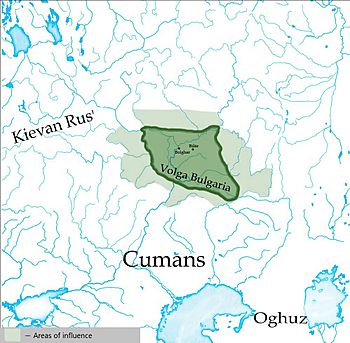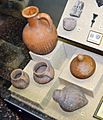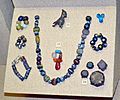Volga Bulgaria facts for kids
Quick facts for kids
Volga Bulgaria
|
|||||||||
|---|---|---|---|---|---|---|---|---|---|
| 7th century–1240s | |||||||||
 |
|||||||||
| Capital | Bolghar Bilär |
||||||||
| Common languages | Bulgar, Turki | ||||||||
| Religion | Tengrism, later Sunni Islam (after Almish Iltäbär) | ||||||||
| Government | Monarchy | ||||||||
| Ruler, Emir | |||||||||
|
• 9th century
|
Kotrag, Irhan, Tuqyi, Aidar, Şilki, Batyr-Mumin | ||||||||
|
• 10th-12th centuries
|
Almish Yiltawar, Mikail ibn Jafar, Ahmad ibn Jafar, Ghabdula ibn Mikail, Talib ibn Ahmad, Mumin ibn al-Hassan, Mumin ibn Ahmad, Abd ar-Rahman ibn Mumin, Abu Ishak Ibrahim ibn Mohammad, Nazir ad-Din | ||||||||
|
• 13th century
|
Ghabdula Chelbir | ||||||||
| Historical era | Middle Ages | ||||||||
|
• Established
|
7th century | ||||||||
|
• Conversion to Islam
|
922 | ||||||||
|
• Conquered by the Mongols
|
1240s | ||||||||
|
|||||||||
| Today part of | Russia | ||||||||
Volga Bulgaria was a powerful historical state. It existed from the 7th to the 13th centuries. It was located around the Volga River and Kama River in what is now European Russia.
Volga Bulgaria was home to many different groups of people. These included Turkic Bulgars, various Finnic and Ugric peoples, and many East Slavs. Its location was very important for trade. It connected traders from Arab lands, Norse areas, and Avars.
Contents
History of Volga Bulgaria
How the State Began
We don't have many original writings from Volga Bulgaria. Most of what we know comes from sources written by Arabic, Persian, Indian, or Russian people. We also learn a lot from digging up old sites.
The land of Volga Bulgaria was first settled by Finno-Ugric peoples, like the Mari people. The original Bulgars were Turkic tribes. They first lived north of the Black Sea. As they moved west, they came under the rule of the Khazars.
Around 630 AD, they formed a state called Old Great Bulgaria. But the Khazars destroyed it in 668 AD. Some Bulgar tribes moved to the Idel-Ural region in the 8th century. They became the main group there by the late 9th century. They united other tribes in the area.
Other Bulgar tribes moved west along the Danube River. They settled in what is now Bulgaria. There, they joined with the Slavs. They started speaking a South Slavic language and followed the Eastern Orthodox faith.
Most experts believe the Volga Bulgars were first ruled by the Khazars. Over time, Volga Bulgaria grew stronger. It slowly became free from Khazar influence. Around the late 9th century, the different groups started to unite. They made Bolghar their capital city. This city was about 160 km south of modern Kazan.
Volga Bulgaria became fully independent after the Khazar state was destroyed. This happened when Sviatoslav conquered Khazaria in the late 10th century. After this, the Bulgars no longer had to pay tribute to the Khazars.
Becoming an Islamic State
Volga Bulgaria officially adopted Islam in 922 AD. This was 66 years before Kievan Rus' became Christian. In 921, their ruler, Almış, sent a messenger to the Caliph. He asked for religious teachers. The next year, an embassy came back with Ibn Fadlan as a secretary. Many Muslims already lived in the country.
The Volga Bulgars tried to convince Vladimir I of Kiev to become Muslim. But Vladimir refused. He said the Rus' people could not give up wine. He called wine "the very joy of their lives."
Volga Bulgaria controlled the middle part of the Volga River. This allowed them to control much of the trade between Europe and Asia. This was very important before the Crusades opened up other trade routes.
The capital city, Bolghar, was a busy and rich city. It was as big and wealthy as the greatest cities in the Islamic world. Bolghar traded with many places. These included Vikings in the north and Baghdad in the south. They also traded with Western Europe and China in the east.
Other important cities were Bilär, Suar, Qaşan, and Cükätaw. Modern cities like Kazan and Yelabuga started as border forts for Volga Bulgaria. Some old Volga Bulgarian cities have not been found yet. But they are mentioned in old East Slavic writings. These include Ashli, Tuxçin, İbrahim, and Taw İle. Some of these cities were destroyed during and after the Golden Horde invasion.
The Rus' kingdoms to the west were the only real military threat. In the 11th century, the country was attacked several times by the Rus'. Later, in the early 12th and 13th centuries, the rulers of Vladimir often attacked Volga Bulgarian cities. They wanted to protect their eastern border. Because of pressure from the Rus' in the west, the Volga Bulgars moved their capital from Bolghar to Bilär.
The Decline of Volga Bulgaria
In September 1223, a small group of Genghis Khan's army entered Volga Bulgaria. They were led by Uran, son of Subutai Bahadur. But they were defeated in the Battle of Samara Bend.
In 1236, the Mongols returned. Within five years, they conquered the entire country. At that time, Volga Bulgaria was also dealing with internal conflicts. After this, Volga Bulgaria became part of the Golden Horde. It was split into several smaller areas. Each of these areas became a vassal (a state that owed loyalty) to the Golden Horde. They were given some freedom to rule themselves. By the 1430s, the Khanate of Kazan became the most important of these areas.
People of Volga Bulgaria
A large part of the people in the region were Turkic groups. These included the Sabirs, Barsil, Bilars, and Baranjars. Some of the mysterious Burtas people were also there. Modern Chuvashes say they are descendants of the Sabirs. The Kazan Tatars claim to be descendants of the Volga Bulgars.
Other groups included Volga Finnic and Magyar tribes. These included the Asagel and Pascatir. The Bisermän people probably came from these groups. Some historians say that over 80% of the country's people died during the Mongol invasion. The people who survived mostly moved to northern areas. These are the lands of modern Chuvashia and Tatarstan. Some independent small states appeared in these areas.
The grassy areas of Volga Bulgaria might have been settled by nomadic Kipchaks and Mongols. Farming in the region greatly declined. Over time, the cities of Volga Bulgaria were rebuilt. They became important centers for trade and crafts in the Golden Horde. Some Volga Bulgars, especially skilled workers, were forced to move to Sarai and other southern cities of the Golden Horde. Volga Bulgaria remained a place known for its farming and handicrafts.
Images for kids
-
Adzes, tools from Volga Bulgaria, 13th-14th century
See also
 In Spanish: Bulgaria del Volga para niños
In Spanish: Bulgaria del Volga para niños






